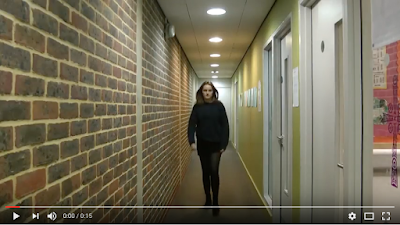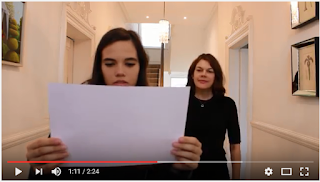 Throughout the process of making the title sequence to a film, I have learnt how to use final cut, including different types of editing and inserting sound. My skills have developed since doing the first 2 filming tasks and this is very visible when you compare them. For example, to the right is the first shot in my preliminary task and it is out of focus, so you can't clearly see Becky's facial features. This is a very simple error that can easily be fixed.
Throughout the process of making the title sequence to a film, I have learnt how to use final cut, including different types of editing and inserting sound. My skills have developed since doing the first 2 filming tasks and this is very visible when you compare them. For example, to the right is the first shot in my preliminary task and it is out of focus, so you can't clearly see Becky's facial features. This is a very simple error that can easily be fixed.
Another way I have developed since my preliminary task is learning how to effectively get all characters in the frame. In the two shots to the left the camera is too close to the characters so their heads get slightly trimmed and it looks very unprofessional. This can be compared to the shot below that is in our opening sequence, the camera doesn't trim the heads of the protagonist and her mum.


When making our product we had to be especially careful that the diegetic sound matched the scene. In my preliminary task there was an instance when the sound suddenly cuts off. At the end of the first shot to the right you hear the door closing, but after the cut to the shot where the girl sits down, the sound of the door closing suddenly disappears. This can cause confusion for the audience and can also make the shot and the actions within the shot seem very unrealistic.
There were both editing and camera mistakes in our 'The Package' practical task, a major mistake we made was breaking the 180 degree rule, this made the shot below confusing as the perspective reversed. It was very important not to make this mistake in our opening, unless it is for artistic effect, as it makes the audience more aware that what they are watching isn't real.
A big camera error we made in our practical task was not checking the level on the tripod before we took the shot, we didn't realise we made the mistake until we saw it on a big screen, as it wasn't visible on the small camera screen. But although this made the shot very distorted and looked like the corridor was slanted it taught us the importance or making sure the tripod is level and not assuming that it is, the two shots below show the slanted shot on the left and a level shot in our opening.
The errors that I made in the preliminary task and the practical task were very beneficial to my final title sequence, as they made me more aware of what could go wrong and things to check before filming a shot. This was so that we could achieve continuity within our product so that it made sense to the audience as well as engaging them and making them want to watch the rest of the film.
Although the process of filming the title sequence was very rewarding we faced a few obstacles during filming and editing. On the first day of filming we didn't have a tripod with us so several of the shots we did that day were shaky and looked amateur. So this set us back and we were slightly rushed for time.
An issue that we realised after filming was that we broke the continuity in a small part of the opening, as in one shot the protagonist leaves her bedroom without shoes on then she walks downstairs and she has shoes on, but we did not show her putting them on. Although we made this minor mistake the continuity in the other parts of the sequence is kept and we did this by ensuring the colours of the shots matched and that our actors wore the same clothes on the days of shooting.
Another problem we came across was that we wanted to include more shots but due to time restrictions we were unable to, this meant that we also had to significantly cut down many shots. Although we did want the particular shots to be in the opening sequence we benefitted from taking them out as it would be slower and less suspenseful, so the audience would not have been as engaged and possibly wouldn't want to continue watching it. Two of the shots we had to cut out are shown below.
Overall creating this two minute title sequence was a challenging but valuable process and I started with a simple understanding of using cameras and editing but during the process developed many skills and now have a much more advanced understanding.






No comments:
Post a Comment